Price and price performance have been hot topics for Wine Lister’s recent blog posts across several regions (Burgundy, Champagne, Tuscany). The Rhône Valley flies further under the radar than these as a region for investment, perhaps in part because its two distinct vineyard areas – North and South – are too different to be cast under the same umbrella. This week’s top five examines the highest prices in the Northern Rhône.
In first place is Domaine Jean-Louis Chave’s Hermitage Cuvée Cathelin. With an average price of £5,248 (per bottle in-bond), it is almost 20 times more expensive than the average of the other four wines in this week’s group. The small quantity of wine, made only in the best years, combined with a Quality score of 977 – the best of this week’s top five – go some way to explaining the four-figure price tag. (Interestingly, the most expensive wine in the Southern Rhône, Buzz Brand Château Rayas’ Chateauneuf-du-Pape, costs an average of £478, or just 9% of the Cuvée Cathelin).
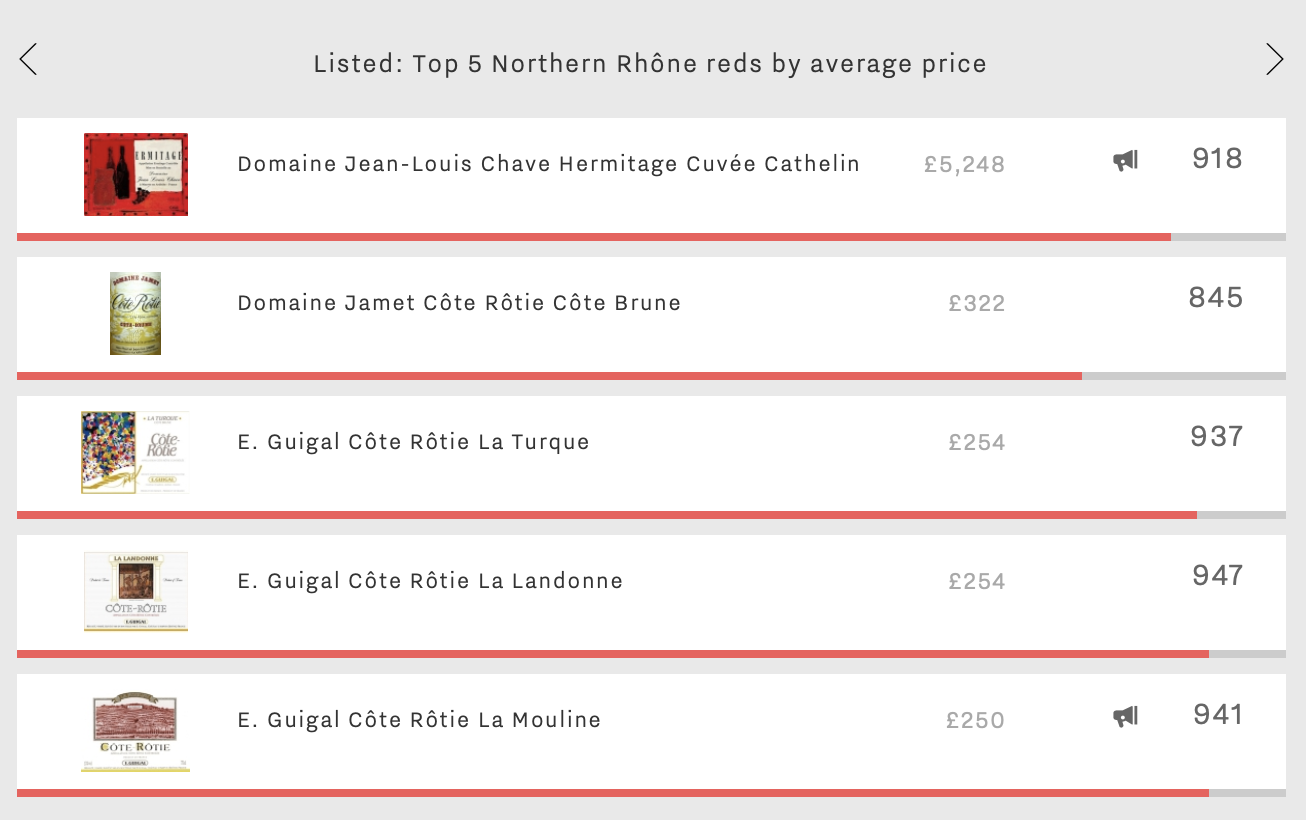
Back in the Northern Rhône, the next of this week’s top five is Domaine Jamet’s Côte Rôtie Côte Brune. Although £4,926 less expensive than this week’s number one, at £322 per bottle in-bond, it actually achieves the best three-year price performance, with a compound annual growth rate (CAGR) of 24.7%. With an average production volume of just 2,400 bottles per year, it is perhaps unsurprising that the wine’s Brand and Economics scores (at 763 and 759 respectively) are lower than its Quality score (946), as it appears in only 8% of the world’s best restaurants, and just three bottles were traded at auction internationally last year.
The remaining wines of this week’s top five hail from the same producer, Guigal, and come as a trio affectionately-known to the trade as “La-Las”. Though close together in price, it is interesting to see the subtle differences between these three Côte Rôtie across Wine Lister’s 13 score criteria.
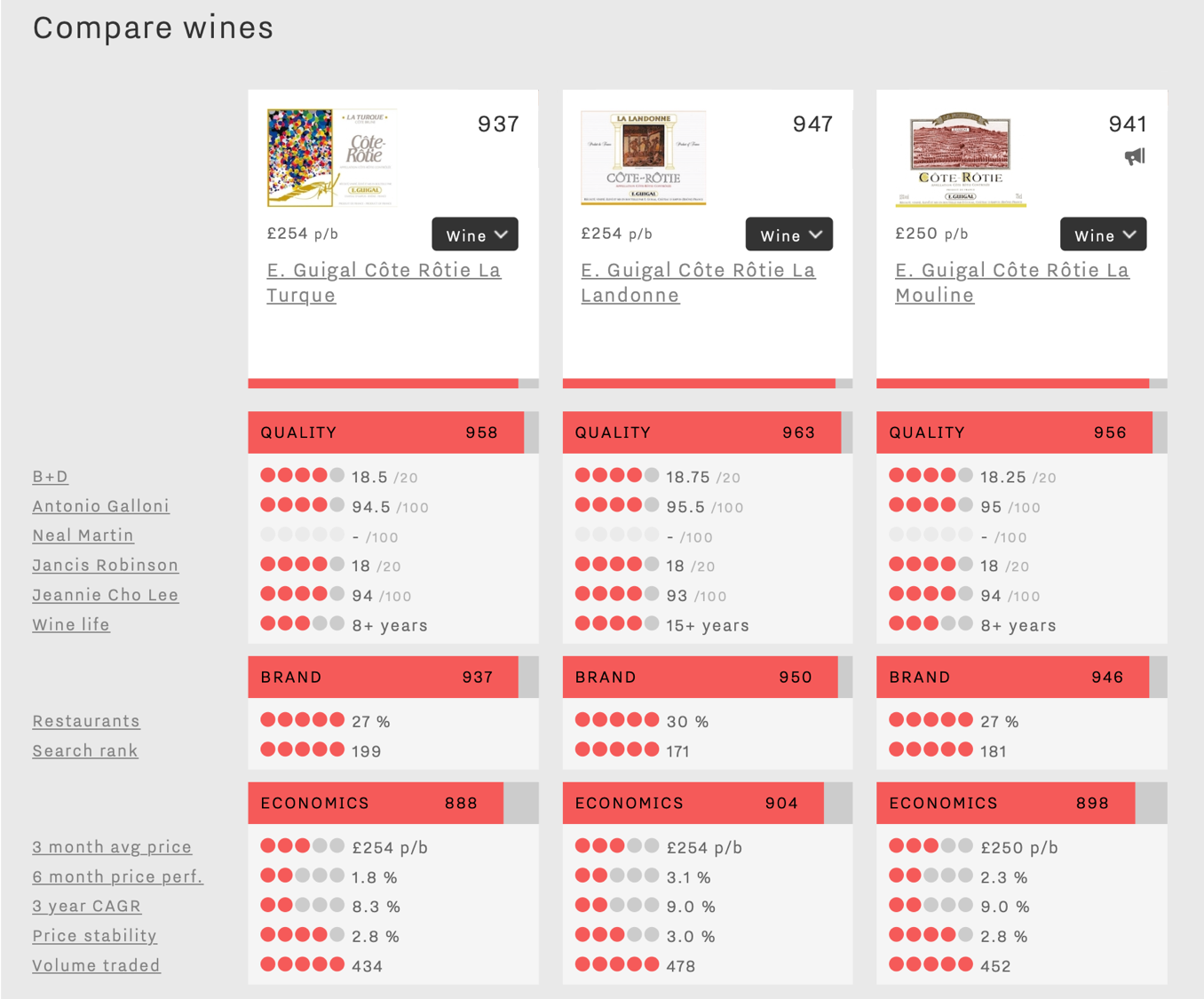
The chart above, created using Wine Lister’s Comparison tool, proves La Turque to be the lowest-scoring of the three overall. It shows slightly less demand with a lower search rank of 199 out of the c.4,000 wines on Wine Lister, whereas its siblings earn more monthly searches on Wine-Searcher. It also under-performs against the other two in economic terms, with lower long- and short-term price growth, and fewer bottles traded annually at auction.
By contrast, La Landonne achieves the top Quality score of 963 (and an average wine life just under twice that of its siblings), the best brand strength, and the highest average number of bottles traded annually at auction (478).
While La Mouline has the lowest average price of the three (£250 per bottle in-bond), it is the only one to earn Wine Lister’s Buzz Brand stamp, and achieves the joint-best three-year price performance with La Landonne – a CAGR of 9%.
With our founder, Ella Lister, just back from tasting the latest releases at Benvenuto Brunello in Montalcino, we thought we’d dig deeper into the data behind the appellation’s top wines. The pyramid system in the region means that most producers make at least three wines: in the middle, a Brunello di Montalcino DOCG Annata (or “vintage”); in good years, a Riserva (with longer ageing but also nearly always the best selection of grapes from the estate); and at the bottom of the pyramid, a Rosso di Montalcino DOC, producing fresher, approachable wines requiring less ageing.
This allows, and indeed encourages, a healthy level of selection in the region. At last weekend’s event, the vintages on show were 2013 Brunello Riserva (excellent), 2014 Brunello Annata (a tricky vintage, with some producers declassifying to Rosso di Montalcino), and Rosso di Montalcino 2017. There is also a trend in the Brunello DOCG towards vineyard-specific crus, such as Casanova di Neri’s Tenuta Nuova or Il Marroneto’s Madonna delle Grazie, both of which feature in this week’s top five: top Brunellos by Economics score.
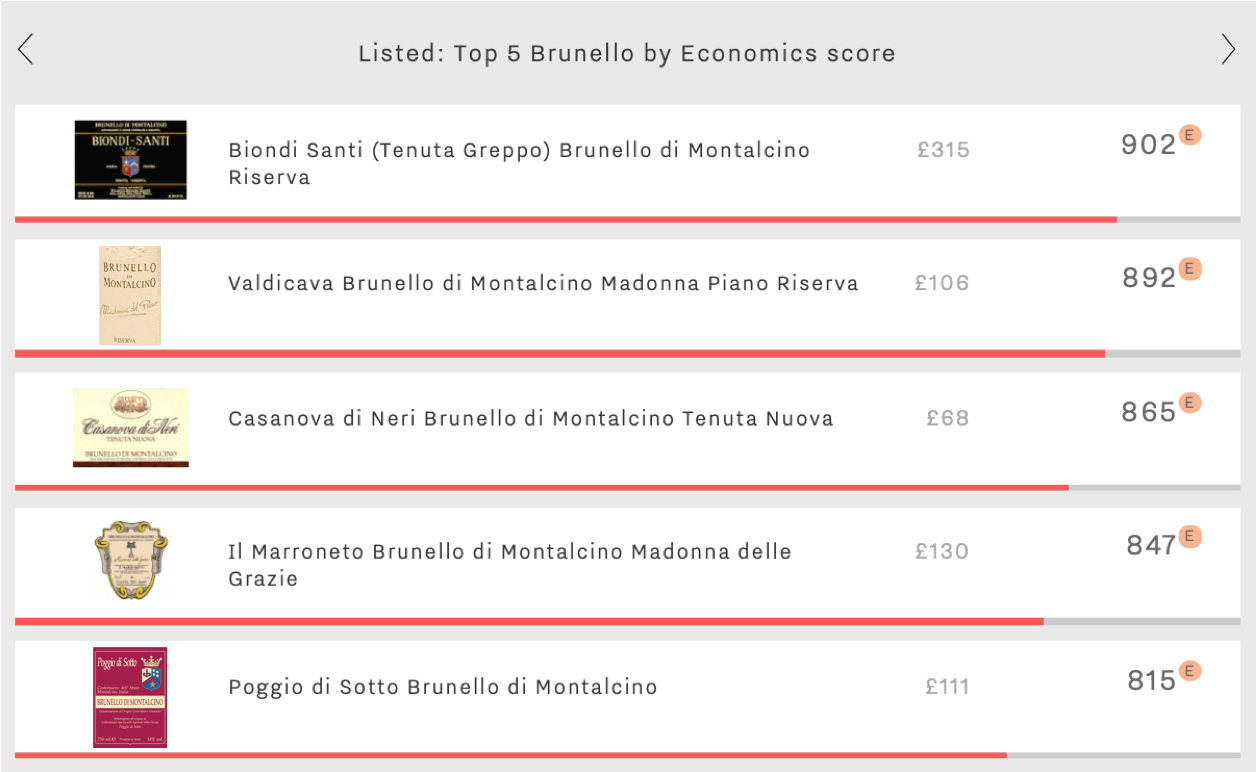
When examining the economic profile of Brunello wines, we see that Riservas tend to have higher Economics scores than Annatas, in line with their higher Quality scores. The best-performing Brunello by Economics score is Biondi Santi’s Brunello di Montalcino Riserva, with a score of 902. It earns the number one spot of this week’s top five with the highest price at £315 per bottle in-bond, and annual auction trading volumes of 458 bottles. The wine also outperforms the rest of the group for both Brand and Quality scores (904 and 938 respectively).
While Riservas are strong economically speaking, Annatas often have stronger Brand scores than their longer-aged counterparts, being produced in larger quantities and thus achieving greater visibility. In second place is Valdicava’s Brunello di Montalcino Madonna Piano Riserva, with an Economics score of 892, whereas its straight Brunello has a Brand score 57 points above its “big” brother, an example of the potential branding conundrum surrounding Brunello and other parts of Tuscany with a Riserva denomination. Nonetheless, the Riserva shows better price performance, with a compound annual growth rate (CAGR) of 15.2%, and an average of 257 bottles sold at auction annually.
Specific “crus” can also perform better than their straight Brunello Annatas in economic terms. In third place is Casanova di Neri’s Brunello di Montalcino Tenuta Nuova with an Economics score of 865. Despite having the lowest Quality score (841) and lowest price (£70) of the group, it earns this week’s second-highest Brand score (887).
In fourth place is Il Marroneto’s Brunello di Montalcino Madonna delle Grazie, the winery’s top cru, produced from grapes grown around the historic chestnut flour store house, and below the church by the same name. It has an Economics score of 847, benefitting from by far the best long-term price performance of this week’s top five, with a compound annual growth rate (CAGR) of 22.9%. Moreover, it sits just one point shy of this week’s number one in Quality terms (937) at 40% of the price – £130.
Rounding out the group is Poggio di Sotto’s Brunello, with an Economics score of 815.
While Super-Tuscans have been recognised for their investment potential for some time, Brunello still sits rather in the shadow of its Bordeaux-blend brothers. In Wine Lister’s first Tuscany market study, conducted in 2017, Brunello held nine places out of the top 25 Tuscan Economics scores. Today that number has increased to 14, as Brunello – Montalcino’s very own, highly ageworthy selection of the Sangiovese grape – goes from strength to strength.
At the end of last year, Wine Lister released its first ever Champagne report. As well as exploring a handful of key trends as identified by Wine Lister’s Founding Members, the report also sheds light on top Champagnes as compared to other regions in terms of economic performance.
Prices of the top Champagnes (Dom Pérignon, Krug Vintage, Louis Roederer Cristal, Salon Le Mesnil and Dom Pérignon Rosé) have seen a compound annual growth rate (CAGR) of 4.8% over the last six years. Relative to other major fine wine regions, this long-term growth is slow, as shown in the chart below, but also stable.

One notable advantage of Champagne as an investment option it its low volatility. Indeed, Champagne prices show a much better level of stability in the secondary market (deviating by just 2.5% from the average price over 12 months) than any other major fine wine region. Slow and steady wins the race.

Moreover, recent price performance shows Champagne accelerating. Prices of top Champagnes are starting to grow at a faster rate than their counterparts in California, Bordeaux, and Tuscany, beaten only by Piedmont and the seemingly unmatchable Burgundy. Indeed, as of December 2018 top Champagnes had seen a 12-month price growth of 11%. The region’s potential for long-term investment is already being acknowledged by the trade, with one of our Founding Members, a top tier UK merchant commenting “Champagne (Salon especially) has experienced solid growth and has become a reliable investment for collectors”.
Salon Le Mesnil is the number one performing Champagne for price performance, with an Economics score of 978, closely followed by Krug’s Clos d’Ambonnay (962). Krug also tops the Champagne Economics charts with its Clos du Mesnil, Brut Vintage, and Collection. Interestingly the only NV Champagne to appear within the top 10 Champagnes for Economics is grower Jacques Selosse’s Brut Initial, with an Economics score of 911. Its price, £106 (per bottle in-bond), is a mere 18% of the average price of the other nine top Champagnes by Economics score.
To read more key findings from our in-depth Champagne study, read the free summary here. (The key findings and full study are also available to download in French on the Analysis page.)
To many a wine expert, Riesling is amongst the world’s finest white wine grape varieties, perhaps thanks to its versatile nature. The aromatic grape does well as both a sweet and dry wine, to drink straight away or suitable for long-term ageing. This week Wine Lister looks at the top five Rieslings under £100 by Quality score, which all hail from Alsace or the Mosel.
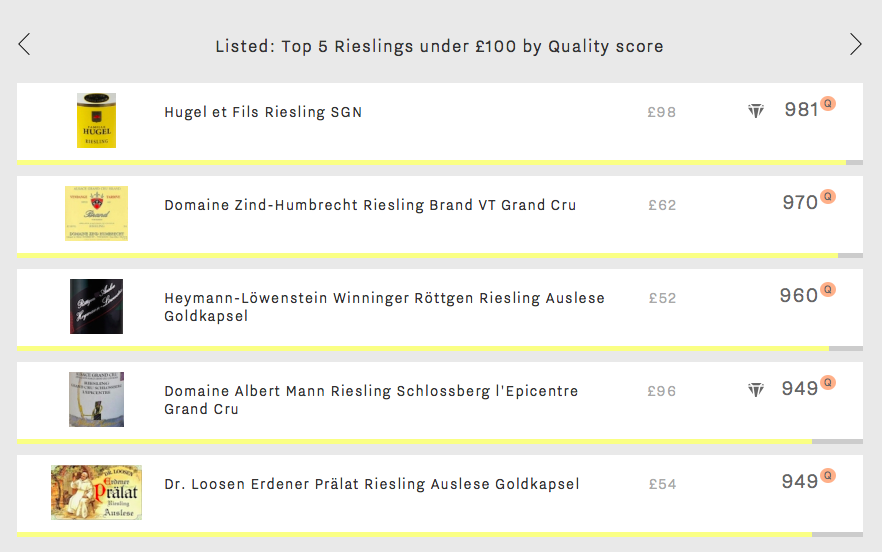
Hugel et Fils’ Riesling SGN takes the top spot this week with a Quality score of 981. This phenomenal Quality score is in part the result of an average wine life of 24 years (compared to 13 years for the rest of this week’s top five). The Riesling SGN from Hugel is therefore perhaps justifiably this week’s most expensive choice, at an average price of £98 per bottle in-bond. Sadly, it might take a Christmas miracle to source this in time for next week’s festivities. An average of just 600 bottles are produced of this Wine Lister Hidden Gem each year.
Next is Domaine Zind-Humbrecht’s Riesling Brand VT with a Quality score of 970. Though in second place for Quality, it achieves this week’s best Economics score of 633 (and also this week’s best overall Wine Lister score) – despite only 18 bottles of it having been traded at auction in the last year. It is the short-term price performance that really boosts the Economics score – the price having increased by 17% in the last six months.
In third place is this week’s first German wine – Heymann-Löwenstein’s Winninger Röttgen Riesling Auslese Goldkapsel. It achieves a Quality score of 960, and at only £52 per bottle in-bond it is this week’s most affordable option.
The two remaining spots of this week’s top five share the same Quality score (949). Domaine Albert Mann Schlossberg l’Epicentre Grand Cru is this week’s second Hidden Gem. Its Hidden Gem status is confirmed by a modest Brand score of 255 – the lowest of the group, due to presence in just 1% of the world’s top restaurants, and being only the 3,797 most-searched-for of Wine Lister’s wines on Wine-Searcher.
Rounding off the group is the second Riesling from Germany, Dr. Loosen Erdener Prälat Auslese Goldkapsel. If you are looking for Quality look no further than its 2006 vintage, which achieves a Quality score of 975 at an average price of £44 per bottle in-bond (compared to the wine’s overall average price of £54 in-bond). Its excellent quality-to-price ratio earns it a spot as one of Wine Lister’s Value Picks – indeed, it is given high praise from Wine Lister partner critic, Antonio Galloni, claiming it to be a “…massive and yet somehow delicate auslese of stunning quality”.
It’s the most wonderful (if most expensive) time of the year. Wine Lister Value Picks help you to avoid compromise on your seasonal drinking choices, identifying wines and vintages with the best quality-to-price ratios. This week’s top five looks at some affordable options for you – still with impressive Quality scores – complete with two Ports in the mix to keep us feeling festive. With Italy and Portugal sharing the top five (and even the top 10) red Value Picks by Quality score, Wine Lister’s Christmas drinking picks stick firmly to Mediterranean climes.
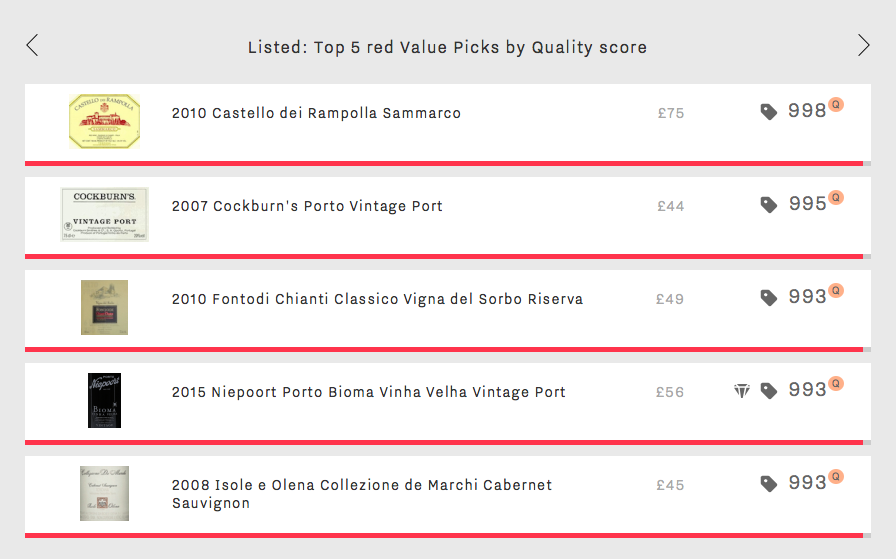
In first place is Castello dei Rampolla Sammarco 2010. Although it is this week’s most expensive option (at £75 per bottle in-bond* vs. an average £49 of the four other wines of this top five) the spectacular Quality score of 998 is impossible to ignore. Indeed, it earns the highest Quality score of any 2010 red on Wine Lister, alongside three others – Castello dei Rampolla’s Alceo, Cerbaiona Brunello di Montalcino, and Vietti Barolo Ravera – all of which are at least £71 more expensive. Sammarco 2010’s remarkable Quality score is due a perfect score of 100/100 from Vinous’ Antonio Galloni, who describes it as “stunning” and “magnificent”.
Next is this week’s first port – Cockburn’s Vintage Port 2007. With a Quality score of 995 and price of £44 there can be no doubt about its status as a Value Pick. It has just entered its drinking window, and with a predicted wine life of 53 years, it could make for the perfect Christmas gift (if you can refrain from drinking it yourself).
The group’s second port, Niepoort Bioma Vinha Velha Vintage Port 2015, shares a Quality score of 993 with the last three spots of this week’s top five. It is the only one of this week’s Value Picks also to achieve Hidden Gem status – Wine Lister’s Indicator for excellent wines that are yet to receive proper recognition. Although it will not be ready to drink until 2028, at £56 per bottle this is an exceptional value wine to store away for Christmases to come.
Rounding out this week’s top five in Tuscan triumph are Fontodi’s Chianti Classico Vigna del Sorbo 2010 and Isole e Olena’s Collezione de Marchi Cabernet Sauvignon 2008. They have both just entered their drinking windows, but will last for many years to come. Each earning a Quality score of 993, their modest prices of £49 and £44 per bottle respectively provide fantastic value.
All that remains is to wish you a very Merry Christmas.
*Prices shown assume the purchase of a whole case. See more on pricing on our website.
‘Tis the season of dark evenings, woolly jumpers, and open fires. To round out the perfect winter evening, Wine Lister has many a drinking suggestion up our collective cashmere sleeves, but let us start with these top five 20-year-old Châteauneuf-du-Papes by Quality score.
Unsurprisingly, the Southern Rhône beats its Northern sibling for price to quality ratios, with the average Quality score of the top five 1998 Châteauneuf-du-Papes at 968, for an average in-bond price per bottle of £354. Comparatively, the Northern Rhône’s top five 1998 average Quality score is 959 for an eye-watering £882 per bottle.
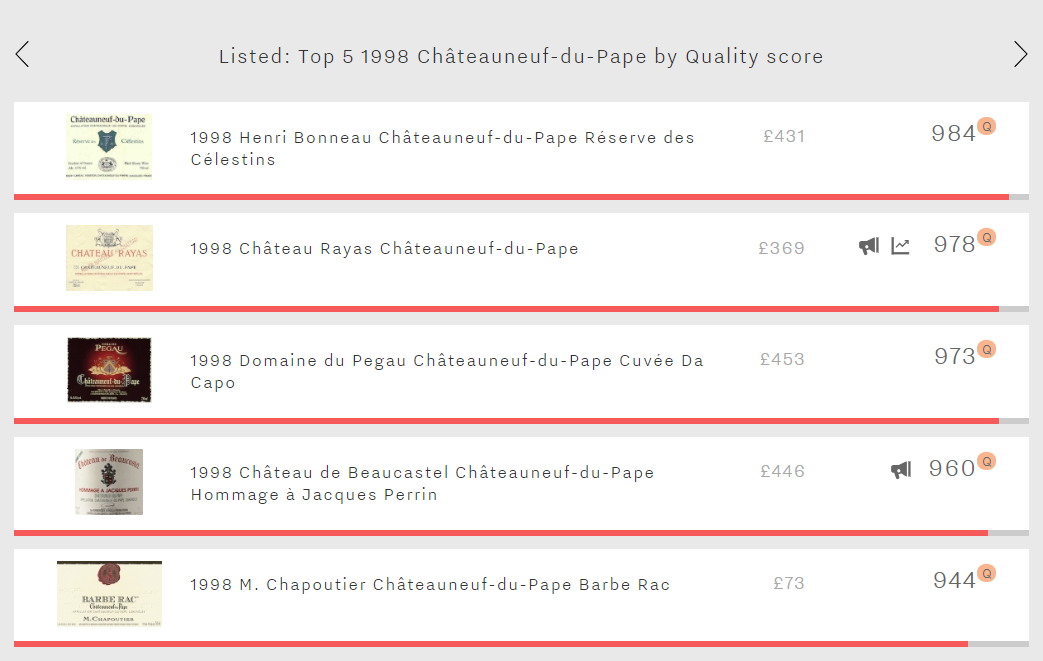
In first place of this week’s top five is Henri Bonneau’s Châteauneuf-du-Pape Réserve des Célestins. Its Quality score of 984 for the 1998 vintage is not only the best of this week’s top five, it is also Bonneau’s highest of the last 20 years, for £431 per bottle in-bond. This price tag is thanks to solid short- and long-term price performance, with six-month price growth of 16.9% and a three-year compound annual growth rate (CAGR) of 16.2%.
Next for 1998 Châteauneuf-du-Papes by Quality score comes this week’s best brand, Château Rayas. Its Brand score of 982 is thanks to presence in 33% of the world’s best restaurants, and an impressive search ranking as the 53rd most-searched-for wine on Wine Lister. Wine Lister partner critic Jancis Robinson awards it full marks, describing it as “not dissimilar” to Rousseau. Its impressive quality and popularity are complimented by the highest Economics score of this week’s top five (988) thanks to the top six-month price performance of 21.7% and a three-year CAGR of 25%.
In third place is Domaine du Pegau’s Cuvée Da Capo 1998 with a Quality score of 973. It is the most expensive of this week’s top five, at £453 in-bond per bottle, perhaps due to its cult-style following. The Cuvée Da Capo achieves the highest average trading volumes at auction of the group (408 bottles per year), according to The Wine Market Journal.
The fourth wine of this week’s top five may also be said to have somewhat of a cult following. Beaucastel’s Hommage à Jacques Perrin 1998 is priced at £446 per bottle in-bond for a Quality score of 960. Despite this excellent score, eight of its last 15 vintages have managed even better Quality scores than the 1998 – indeed Hommage à Jacques Perrin is on average the highest-scoring Châteauneuf-du-Pape on Wine Lister (with an average Quality score of 965).
Finally, M. Chapoutier’s Châteauneuf-du-Pape Barbe Rac 1998 rounds out the group, with a Quality score of 944 and a price of £73 per bottle in-bond (or a mere 17% of the average price of the other four wines combined).
Other than the Rayas, any lucky owners of these bottles should consider cracking them open this Christmas, lest he or she risk missing their respective quality peaks.
Wine Lister recently looked at red Christmas drinking options with the best Bordeaux under £50, and now that the official ‘sparkling season’ is almost upon us, it is high time to consider options for holiday bubbles. Below we examine the all-round best of the best – the top five Grand Cru Champagnes by Wine Lister score.
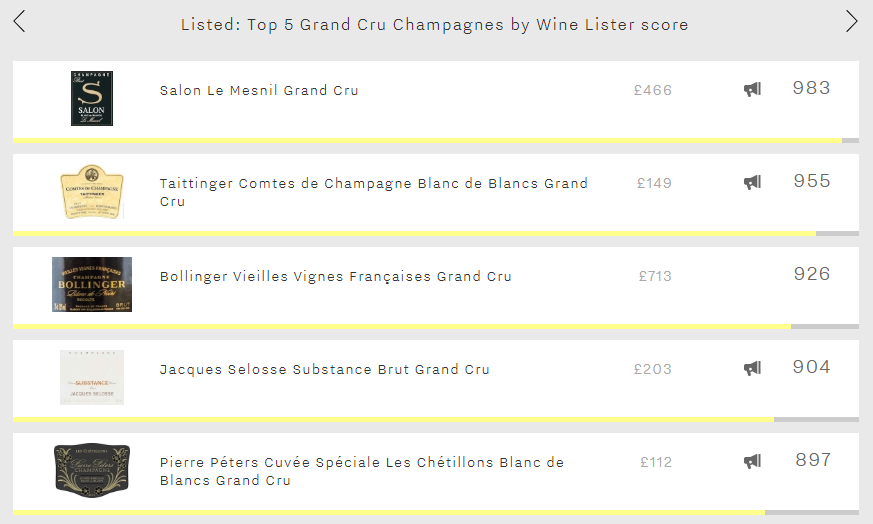
The number one Grand Cru Champagne is the indomitable Salon Le Mesnil (983). It fires on all Wine Lister cylinders, with impressive Quality, Brand, and Economics scores of 980, 989, and 981 respectively, meaning that it leads this week’s top five across each category. Moreover, it is the number one white wine on Wine Lister – still, sparkling, dry, or sweet. If you’re after a memorable bottle to kickstart the holiday season, then look no further than Salon 1996, its best ever vintage. As proof of the extraordinary longevity of top Champagne, the 1996 will be drinking well until at least 2025. Though expensive (£550 per bottle in-bond), you would be well-rewarded for paying the high price, Antonio Galloni calling the 1996 “the ultimate expression of Champagne as a wine”.
Next comes Taittinger’s Comtes de Champagne, whose main strength is its Brand score (976). This is helped by a production volume of c.170,000 bottles per annum – almost twice that of the other four Champagnes of this week’s group combined. It consequently also achieves the highest auction-trading volumes of the group, having traded 789 bottles over the past four quarters, according to our data partner, The Wine Market Journal.
In third place is Bollinger Vieilles Vignes Françaises. The term “vielles vignes” tends to get banded around quite frequently without much meaning, but in this case it carries rare significance. These old vines are planted on French rootstock, predating the spread of phylloxera which lead to the introduction of louse-resistant American rootstock onto the vast majority of France’s vines. As might be expected given the wine’s unique heritage, it comes with a hefty price tag (£713 per bottle in-bond). However, this rarity backs up its high price with an outstanding Quality score (963) – the joint-second best of this week’s top five.
In fourth place is Jacques Selosse’s Substance Brut (904). The only non-vintage wine of the five, it matches the Bollinger Vieilles Vignes Françaises’ excellent Quality score (963). Its outstanding quality, coupled with its tiny production volume of 2,700 bottles per annum, start to explain the £203 price-tag of this NV grower Champagne.
Finally, in fifth place, is Pierre Péters’ Cuvée Spéciale Les Chétillons Blanc (897). Though in fifth place, its impressive Quality (923) and Economics (922) scores suggest it could be a prime choice for cellaring. It achieves the best short and long-term price growth of this week’s top five, having added 16.7% to its price over the past six months, and recording a three-year compound annual growth rate (CAGR) of 36.5%. Any recent vintage would perhaps therefore be better placed under the Christmas tree (for an extremely lucky recipient), rather than on the Christmas table.
Thanks to tiny production quantities, exceptional quality, and increasing popularity, Burgundy tends to be expensive. In Wine Lister’s Burgundy Market Study (published in January this year), we analysed its rapidly-climbing prices. This week’s Listed blog focuses on the very tip of the Burgundy price hierarchy, with the top five by average price.
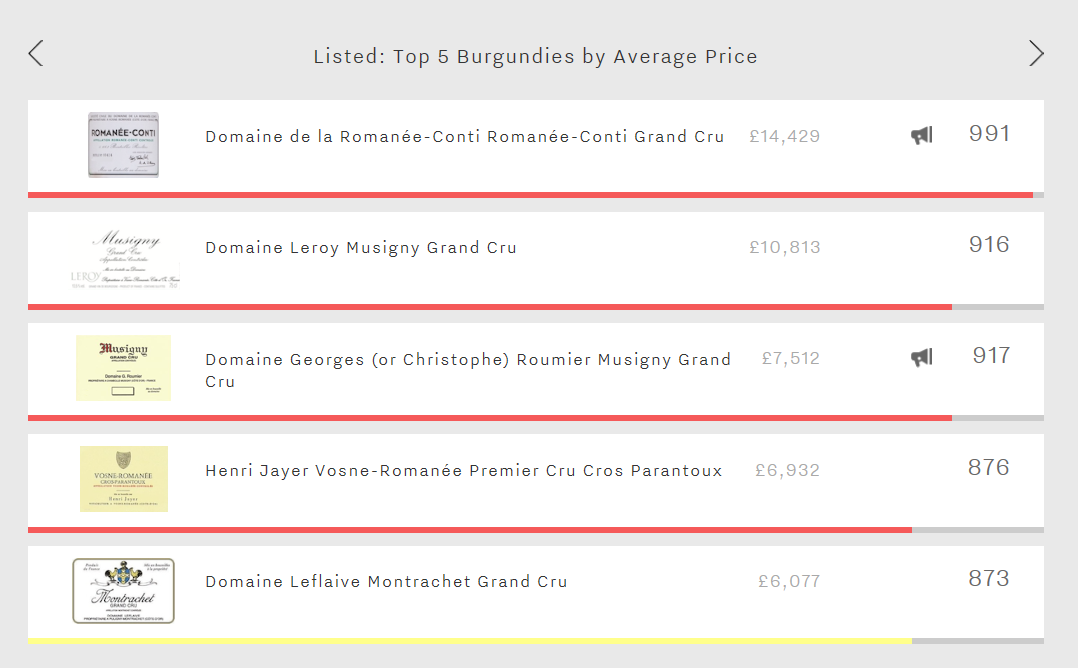
Four of this week’s top five hail from the Côte de Nuits, the first of which is, unsurprisingly, Domaine de la Romanée-Conti’s Romanée-Conti at an average price of £14,429 per bottle in-bond. The high price tag is accompanied by the best red Quality score on Wine Lister (993) and a Brand score of 989. The latter is achieved in part by being the 8th most-searched-for wine on Wine Lister (and indeed gains two and a half times as many monthly searches on Wine Searcher as the remaining wines of this week’s top five combined). Its most recent release – the 2015 vintage, receives a Quality score of 997, with Wine Lister partner critics Bettane + Desseauve and Jancis Robinson both awarding it 20/20. Even if the 2015 vintage is DRC Romanée-Conti’s best-performing in the last 15 years, its price increase of nearly 500% (from £2,925 to £17,496) since release in January is virtually incomprehensible.
In second place is one of two Musignys to feature this week. Domaine Leroy’s Musigny has an average in-bond price of £10,813 per bottle and a Quality score of 988 – just five points behind this week’s number one. Its overall Wine Lister score sits 75 points down from DRC Romanée-Conti, due to a more modest Brand score of 781. Interestingly, Leroy’s Musigny has been qualitatively more consistent over the past five releases than Wine Lister’s highest-quality red – its Quality score deviates a maximum of just one point from year to year since 2010 (compared to DRC Romanée-Conti’s maximum deviation of seven points).
Number three of this week’s top five is the second Musigny, this time from Domaine Georges Roumier. With a slightly lower price tag of £7,512 per bottle in-bond, and the second-highest Brand score of the group, Roumier is somewhat a darling of the trade – indeed, this Musigny is in the top 10% of most talked-about wines by the fine wine trade, according to Wine Lister’s Founding Member Surveys.
The last two spots are taken by wines that each stand alone among this week’s top five for their own reasons. The first, Henri Jayer’s Vosne-Romanée Cros Parantoux at £6,932 per bottle is the only Premier Cru to feature, as well as the only wine no longer in production.
Finally, Domaine Leflaive’s Montrachet Grand Cru is the only white of the group. As the most expensive white Burgundy on Wine Lister at £6,077 per bottle, it also earns white Burgundy’s highest Quality score of 985.
This week some of the Wine Lister team attended the Institute of Masters of Wine‘s Annual Claret Tasting, which this year focused on Bordeaux’s 2014 vintage. Though still young, it is a vintage that is tasting beautifully.
Throughout Wine Lister’s coverage of this year’s en primeur campaign, we found ourselves referring frequently to the 2014 vintage for comparative (and sometimes better) quality, and crucially, better prices. Below we explore the vintage in more detail, looking at Quality and Economics scores by appellation. (Note that this analysis was produced based on the basket of wines represented at the IMW Tasting).
Wine Lister’s holistic and dynamic approach allows us to not only see which appellations produced the vintage’s best wines, but also demonstrates if and how the market has since reacted to each appellation’s relative quality.
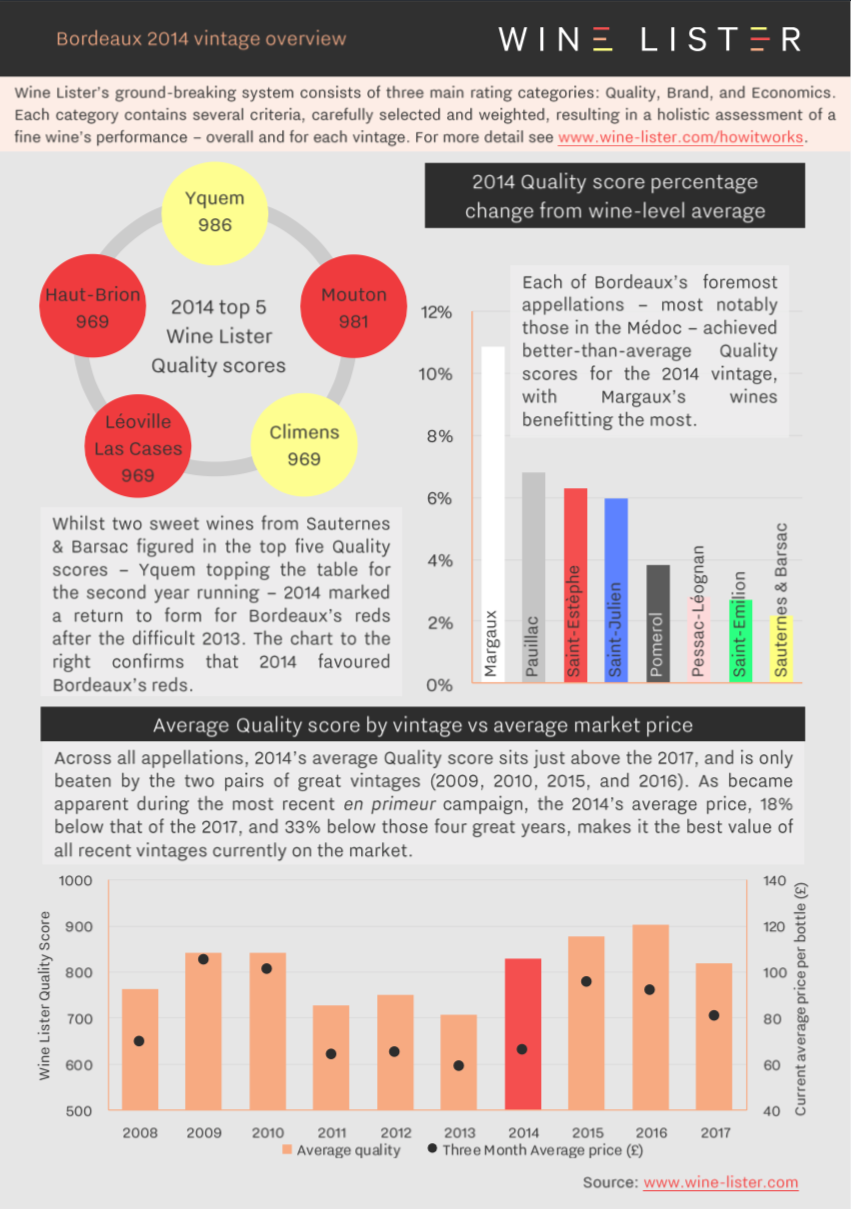
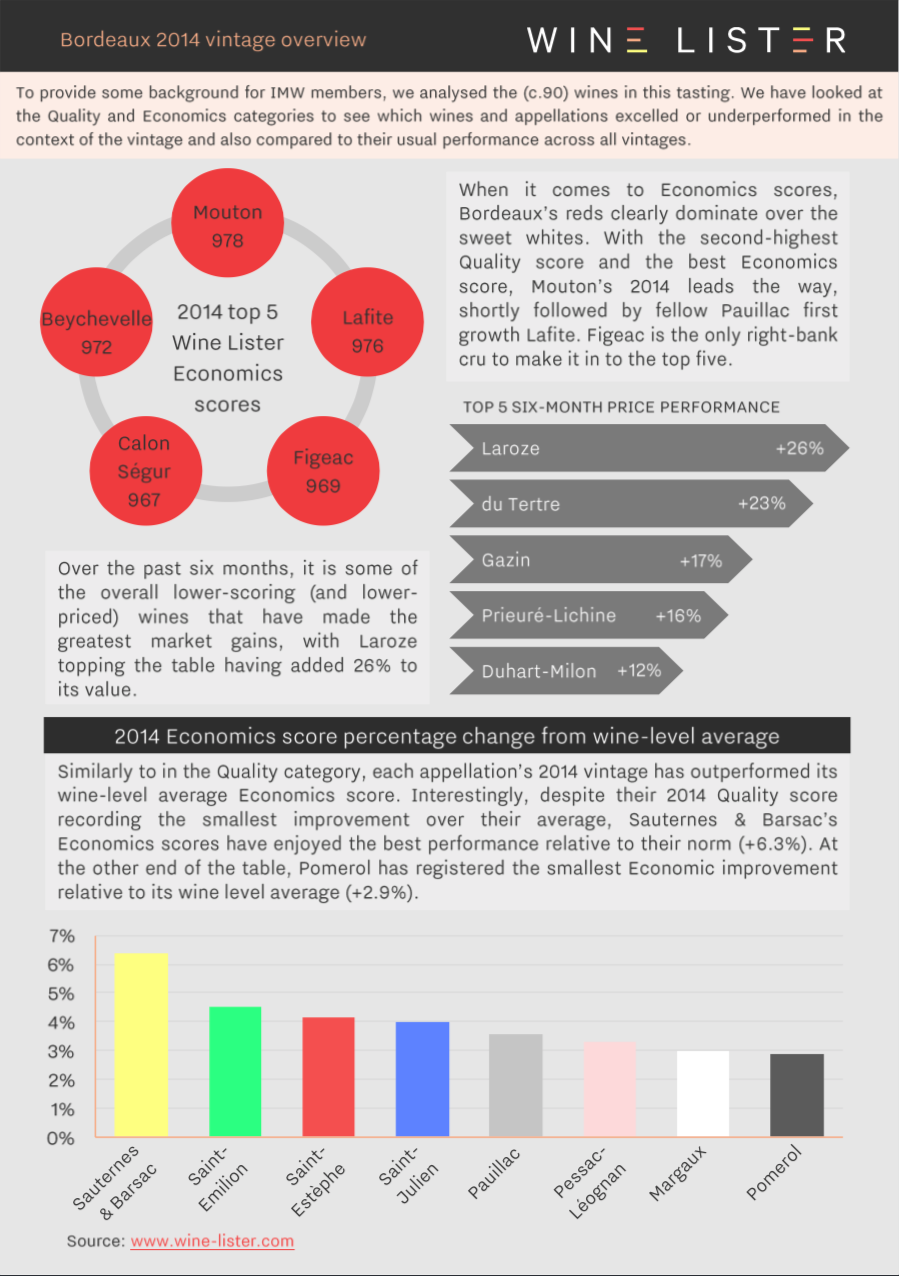
You can download the slide here: Wine Lister IMW 2014 vintage overview
To many wine collectors, the king of Italian wine is Barolo. Its popularity, particularly for older vintages, continues to grow (as proven in our latest restaurant presence analysis). However, the Piedmont sovereign’s Tuscan counterpart – Brunello – should not be overlooked. This week’s top five looks at the best Brunellos by Quality score – and all five achieve scores above 900.
Perhaps unsurprisingly, the top five Barolos by Quality score achieve an average score 34 points higher than this week’s Brunello group (964 vs 929). However, couple this with the fact that the Brunellos tend to cost nearly half as much as their Barolo counterparts (£142 vs £275), and Brunello’s value starts to become clear.
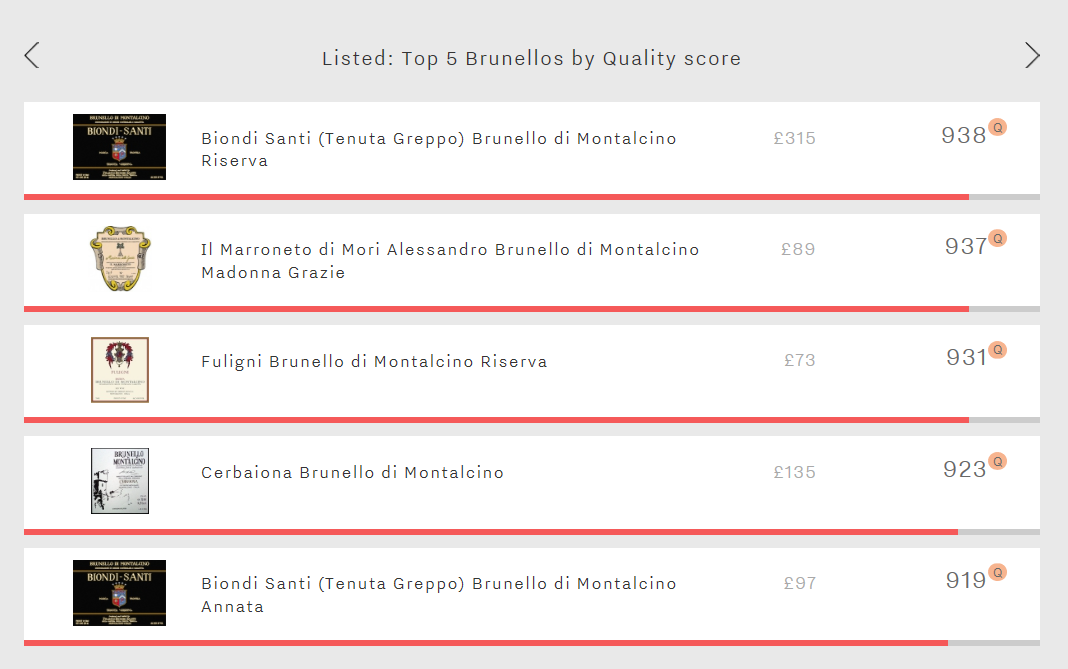
Biondi Santi earns two spots in this week’s top five, with its Brunello Riserva and Brunello Annata bookending the group. The former wins this week’s battle with an impressive Quality score of 938. It also achieves this week’s highest Economics score (941), contributing to its excellent overall Wine Lister score of 926 – also the best of the group. Although, at £315 a bottle it is also more than three times as expensive as the collective average price of the other four (£99).
In second place this week is Il Marroneto di Mori Alessandro Brunello Madonna Grazie. With a Quality score of 937 it is just one point behind this week’s number one – the slightly lower score being due to its shorter average ageing potential (12 vs 19 years). Its 2008 vintage provides the most impressive quality to price ratio of this week’s top five, achieving a Quality score of 938, yet available for as little as £45 per bottle in-bond.
Next in this week’s top five is Fuligni Brunello Riserva with a Quality score of 931. It appears to be the least well-known of the group, with a Brand score of 645. This is down to presence in just 5% of the world’s best restaurants, and being ranked 1,257th for monthly online searches of all Wine Lister’s wines on Wine Searcher. Its relatively modest Brand score could perhaps be the reason for its average price being the least expensive of the group (£73 per bottle).
Cerbaiona’s Brunello takes fourth place, with a Quality score of 923. Though not earning the highest Brand score of this week’s top five, it is still a Brand to watch – Cerbaiona was the only Brunello to feature in both recent top 20 lists for horizontal and vertical restaurant presence gains. Perhaps its increasing popularity is in part thanks to such an impressive score for the 2010 vintage. Vinous awards it 100 points, singing its praises: “The most anticipated wine of the night, the Cerbaiona shows why it belongs in the pantheon of the most epic wines ever made in Montalcino. A Brunello with no beginning and no end, the 2010 Cerbaiona just is. Every aroma, every shade of nuance, every texture is just…perfect.”
Last but not least is Biondi Santi’s Brunello Annata with a Quality score of 919. Though in fifth place for Quality, it achieves the highest Brand score of this week’s top five, at 934. This impressive Brand score is the result of great restaurant presence (17%) and being the 118th most searched-for wine on Wine Lister.












